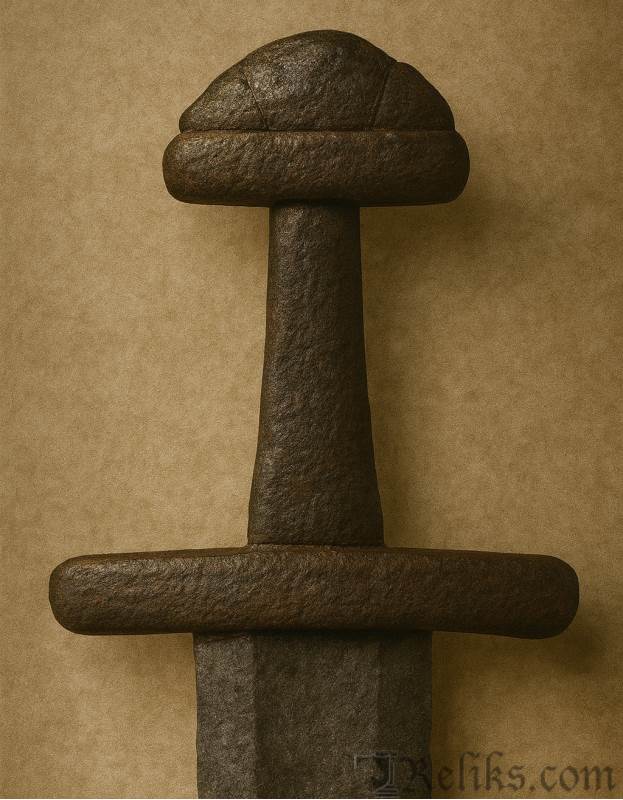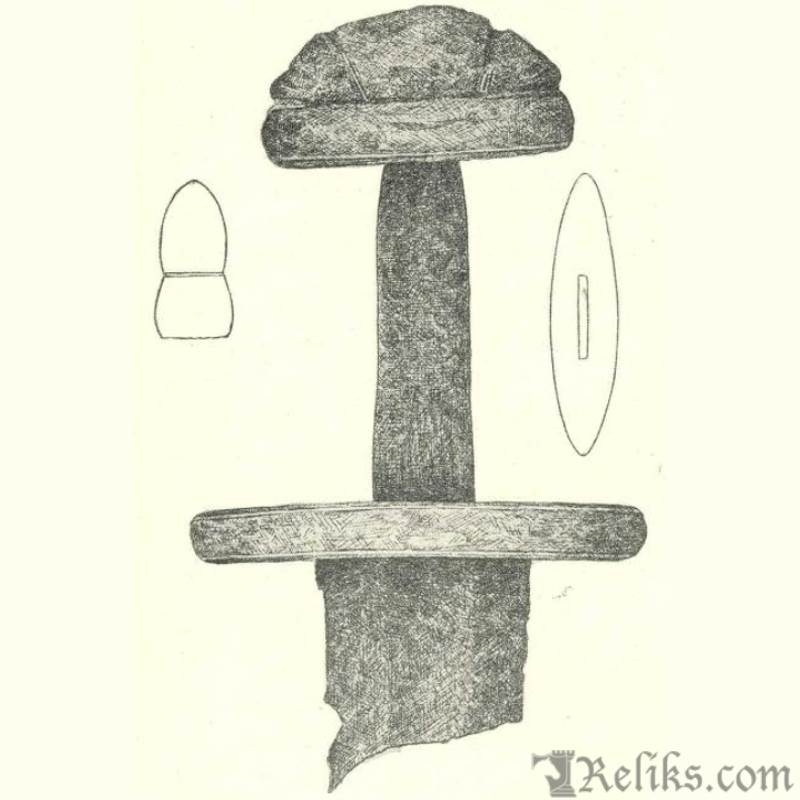Viking Sword Type U (Late 10th Century Simplified Form)
Overview
Type U is one of the rarer Viking sword types, with only eight confirmed examples in Norway and a few more from neighboring regions. What it lacks in lavish decoration, it makes up for in its significance: this type embodies the shift toward more practical, standardized weapons during the closing decades of the Viking Age. Its plain, three-part pommel and straight guards contrast sharply with the ornate Ulfberht swords of the same century, offering a glimpse into the everyday arms carried by warriors outside the wealthiest circles.
Form & Ornament

Viking Sword Type U (Late 10th Century Simplified Form)
Type U swords are defined by their straight guards and low tripartite pommel. Unlike earlier and related types where the middle lobe of the pommel rises boldly above the sides, here the three lobes are almost level — giving the weapon a restrained, flattened silhouette. The cross-sections are slim and pointed, recalling the lighter proportions of Type I.
Most examples are undecorated, though some carry modest enhancements. A sword from Bakke in Jondal (B 4486) features plaited-band ornamentation, while others preserve narrow strips of copper or brass inlaid along the hilt edges. These details show that, while functionality dominated, smiths occasionally added flashes of artistry.
Distribution & Numbers
The type is concentrated in Western Norway and Trøndelag, though individual finds appear as far afield as Innlandet (Toten) and Sogn. Beyond Norway, Petersen identified examples in Finland and the National Museum of Denmark. This limited but scattered distribution suggests that the form was not a major export type, but it was recognized across Scandinavia.
Dating & Archaeological Context
Most evidence points to the mid-to-late 10th century:
- C 2539 (Toten): found with a K-type axe, a K-to-M transitional spear, and an R 565 shield boss — all hallmarks of late Viking Age armament.
- T 11581 (Grong): associated with a slender, youthful spearhead, again signaling the late 10th century.
- C 1779 (Årdal, Sogn): more puzzling, found with an older F-type axe, which may reflect either an heirloom weapon or a regional lag in adoption.
Altogether, the finds suggest a date around 950–1000 CE, though some may extend slightly earlier or later.
Social Context & Historical Significance

Petersen (fig.122)
Type U illustrates an important shift in Viking society. By the late 10th century, the raiding and warrior aristocracy of earlier centuries was giving way to more organized armies and larger-scale battles. Swords became tools of war as much as symbols of prestige.
The simplified design of Type U may reflect this change. While elites still carried richly decorated hilts and foreign imports, many warriors likely bore locally made, no-nonsense swords like these. Their modest ornament hints at a weapon meant for daily use rather than ceremonial display.
The presence of similar examples in Finland and Denmark also shows the shared martial culture of the North Sea and Baltic worlds, where styles spread quickly but were adapted to local tastes and resources.
Closing Reflection
Type U may not dazzle with silver plates or lofty pommels, but that is exactly why it matters. These swords belong to the final chapters of the Viking Age, when the battlefield demanded weapons that were practical, reliable, and more easily reproduced. Where Types H, K, and S projected wealth and prestige, Type U represents the everyday warrior—the farmer called to fight, the retainer in a chieftain’s warband, the man who needed a sword as a tool rather than a treasure.
In their simplicity we see the transition from the heroic age of raiding to the era of larger, more disciplined armies. The plain, low pommels and straight guards speak of standardization: swords no longer made just for display, but for equipping more men at arms. Yet even here, small touches of inlay and ornament remind us that identity and pride still mattered, even in practical tools of war.
For modern observers, Type U swords are invaluable precisely because they show us the “other side” of Viking weaponry. They complete the picture, balancing the glitter of Ulfberht imports with the grounded reality of local craft. In them we glimpse a society on the cusp of change—where war was becoming broader, bloodier, and more organized, and where the sword was not just a badge of status but the common steel of the Viking battlefield.
Core classification based on Jan Petersen, De Norske Vikingesverd (1919). Additional commentary by Reliks.com.